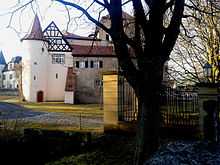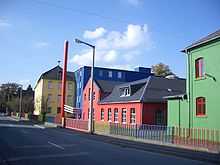Counts of Castell

The family appears already in 1057 with Robbrath de Castello. The County of Castell was created in AD1200, in the modern region of Franconia in northern Bavaria, Germany. Rulership of Castell was shared between the brothers Louis and Rupert II in 1223, and later with the brothers Albert II, Frederick II and Henry I in 1235. The County partitioned into Elder and Younger lines in 1254, which were reunited in 1347 with the extinction of the Elder branch. Castell was repartitioned in 1597 into Castell-Remlingen and Castell-Rüdenhausen. When Count Wolfgang Theodoric of Castell-Castell (itself a partition of Castell-Remlingen) died in 1709, the County of Castell was recreated as a partition. Castell was annexed to Castell-Castell in 1772.
Counts of Castell (1200–54)
- Rupert I (1200–23)
- Louis (1223–30) with...
- Rupert II (1223–35)
- Albert II (Count of Castell (Younger)) (1235–54) with...
- Frederick II (1235–51) and...
- Henry I (1235–54) and...
- Frederick III (1251–4)
Partitioned between Elder and Younger lines
Counts of the Elder Line of Castell (1254–347)
- Henry II (1254–307)
- Rupert II (1307–34)
- Henry III (1334–47)
Line extinct and inherited by the Younger line which renames itself to Castell
Counts of the Younger Line of Castell (1254–347)
- Albert II (Count of Castell) (1254–8)
- Herman II (1258–85)
- Frederick IV (Count of Castell) (1285–347)
Line inherited the Elder branch and was renamed to Castell

Counts of Castell (1347–597)
- Frederick IV, Count of Castell from the younger line (1347–9)
- Herman IV (1349–63) with...
- Frederick VII 1349–76) and...
- John I (1363–84) and...
- William I (1363–99)
- Leonard (1399–426)
- William II (1426–79)
- Frederick IX (1479–98)
- George I (1498–528) with...
- John III (1498–500) and...
- Wolfgang I (1498–546)
- Conrad II (1546–77) with...
- Frederick XI (1546–52) and...
- Henry IV (1546–95) and...
- George II (1546–97)
Partitioned into: Castell-Remlingen and Castell-Rüdenhausen
Counts of Castell (1709–72)
- Louis Frederick (1709–72) with...
- Christian Adolph Frederick (Count of Castell-Remlingen) (1743–62)
Inherited by Count Christian Frederick Charles of Castell-Castell.
After 1806
The family was mediatized in 1806 and 1815, however without loss of its equal-to-royal rank, its two states incorporated into Bavaria. In 1901 both branches received the Bavarian rank of Princes (only in primogeniture), with the title Prince (Serene Highness) for the heads of the branches and the title Count/Countess (Illustrious Highness) for all other members of the House.
Castell-Castell line
- Friedrich Carl (1864-1923), created prince in 1901, m. Gertrud, countess of Stolberg-Wernigerode
- Carl (1897-1945), m. Anna-Agnes, princess of Solms-Hohensolms-Lich
- Albrecht (* 1925), m. Marie Luise, princess of Waldeck and Pyrmont
- (heir apparent): Ferdinand (* 1965), m. Marie-Gabrielle, countess of Degenfeld-Schonburg
Castell-Rüdenhausen line
- Wolfgang (1830-1913), created prince in 1901, m. Emma, princess of Ysenburg and Büdingen in Büdingen
- Casimir (1861-1933), m. Mechtild, countess of Bentinck
- Rupert (1910-1944)
- Siegfried (1916-2007), brother of the former, m. Irene, countess of Solms-Laubach
- Johann Friedrich (1948-2014), m. Maria, countess of Schönborn-Wiesentheid (his sister Donata being the mother of Georg Friedrich, Prince of Prussia)
- Otto Friedrich (* 1985)
Faber-Castell sub-line

Collateral line of Castell-Rüdenhausen: Through the marriage of Count Alexander of Castell-Rüdenhausen (1866–928) with Ottilie Baroness von Faber from a well-known family of industrialists the branch of Faber-Castell was created in 1898.
The company was founded in 1761 at Stein near Nuremberg by cabinet maker Kaspar Faber (1730–84), and has remained in the Faber family for eight generations.[1] It opened branches in New York (1849), London (1851), Paris (1855), and expanded to Vienna (1872) and St. Petersburg (1874).[1] It opened a factory in Geroldsgrün and expanded internationally and launched new products under Kaspar Faber's ambitious great-grandson, Lothar (1817–96).[1] In 1900, after the marriage of Lothar's granddaughter with a cadet of the Counts of Castell, the A.W. Castell enterprise took the name of Faber-Castell and a new logo, combining the Faber motto, Since 1761, with the "jousting knights" of the Castells' coat-of-arms.[2]
The Castell family were mediatised counts of the old Holy Roman Empire, and as such ranked with the reigning dynasties of Europe.[3] In 1901 the head of the family was granted the hereditary title of Prince by Luitpold, Prince Regent of Bavaria.[3] A descendant of the first prince, Count Alexander Friedrich Lothar von Castell-Rüdenhausen (1866–1928) married Baroness Ottilie von Faber (1877–1944), heiress of the Faber pencil "dynasty" in 1898.[3] Although the immensely wealthy Lothar had been ennobled in 1861 and made Baron von Faber in the Kingdom of Bavaria in 1881,[1][4] in the German Empire a mediatised nobleman's marriage to his daughter would have been deemed morganatic, and the Count's trafficking in commerce considered an act of social derogation for a member of the Hochadel, so Alexander renounced his birth rank prior to the marriage. He was granted the new hereditary title of Count von Faber-Castell by Luitpold, Prince Regent of Bavaria for the descendants of his marriage to the Faber heiress.[3][5] Although Alexander and Ottilie divorced in 1918, the Faber business trust had conferred headship of the company on Alexander,[1] who even kept the Fabers' renovated palace at Stein (which would be commandeered to billet journalists during the Nuremberg trials, including Ernest Hemingway and John Steinbeck).[6]
In 1927 Alexander resumed his original name for himself, his second wife (born a countess, Margit Zedtwitz von Moravan und Duppau, 1886–1973), and their son, Count Radulf (1922–2004).[5] His issue by the first marriage had never been considered dynasts of the House of Castell, but they inherited the vast Faber fortune and continue to include Castell in their name with the comital title.[5]
Alexander and Ottilie's only son, Count Roland Lothar Wolfgang Christian Ernst Wilhelm von Faber-Castell (1905–78), inherited headship of the Faber-Castell companies from his parents.[1] By his second marriage in 1938 to Katharina Sprecher von Bernegg (1917–94), Roland was the father of the current head of the family, Count Anton-Wolfgang Lothar Andreas von Faber-Castell. Anton-Wolfgang was born in Bamberg 7 June 1941, was married (briefly) in Las Vegas on 16 June 1986 to Carla Mathilde Lamesch — mother of his only son, Count Charles Alexander von Faber-Castell, who was born in Zürich 20 June 1980 — and he wed secondly, at Stein on 12 December 1987, Mary Hogan (b. 1951), by whom he has three daughters (Katharina, and the twins Sarah and Victoria).[4]
Anton-Wolfgang's niece, Countess Floria-Franziska von Faber-Castell (b. 1974) was married at Kronberg on 17 May 2003 in a much-publicised wedding attended by members of Europe's reigning families, to Donatus, Hereditary Prince of Hesse, a great-grandson of King Victor Emmanuel III of Italy and a grand-nephew of Princess Sophie of Greece and Denmark, sister of Prince Philip, Duke of Edinburgh. Floria is a daughter of Hubertus (1937–71), second son of Roland. Various branches of the Faber-Castell family still flourish, but in the past the Faber and Faber-Castell corporate holdings have usually passed to the eldest male of the patrilineage,[1] currently Count Anton-Wolfgang, third of Count Roland's five sons.[4]
Other items
Castell, Texas, USA is named after Count Carl Frederick Christion of Castell-Castell (1801–50) who was the Vice President and Business Manager at the beginning of the Adelsverein, a German settlement organization.
The present heads of the existing two branches are prince Albrecht of Castell-Castell and prince Johann-Friedrich of Castell-Rüdenhausen.
Literature
- Almanach de Gotha, Gotha 1901 and 1930
References
- ↑ 1.0 1.1 1.2 1.3 1.4 1.5 1.6 Faber-Castell International. The History of the Faber-Castell Company
- ↑ Faber-Castell International. The Company Logo
- ↑ 3.0 3.1 3.2 3.3 Almanach de Gotha. 1910. Perthes, p. 107, 109, 120–1. Deuxième Partie.
- ↑ 4.0 4.1 4.2 "At the Sharp End". The Economist. March 2007.
- ↑ 5.0 5.1 5.2 Huberty, Michel; Giraud, Alain; Magdelaine, F. and B. (1991). L'Allemagne Dynastique, Tome VI. France: Laballery. pp. 308–311. ISBN 2-901138-06-3.
- ↑ Faber-Castell International. The Faber-Castell Castle
External links
- Biography (English) of Count Carl of Castell-Castell
- Genealogy of the House of Castell

